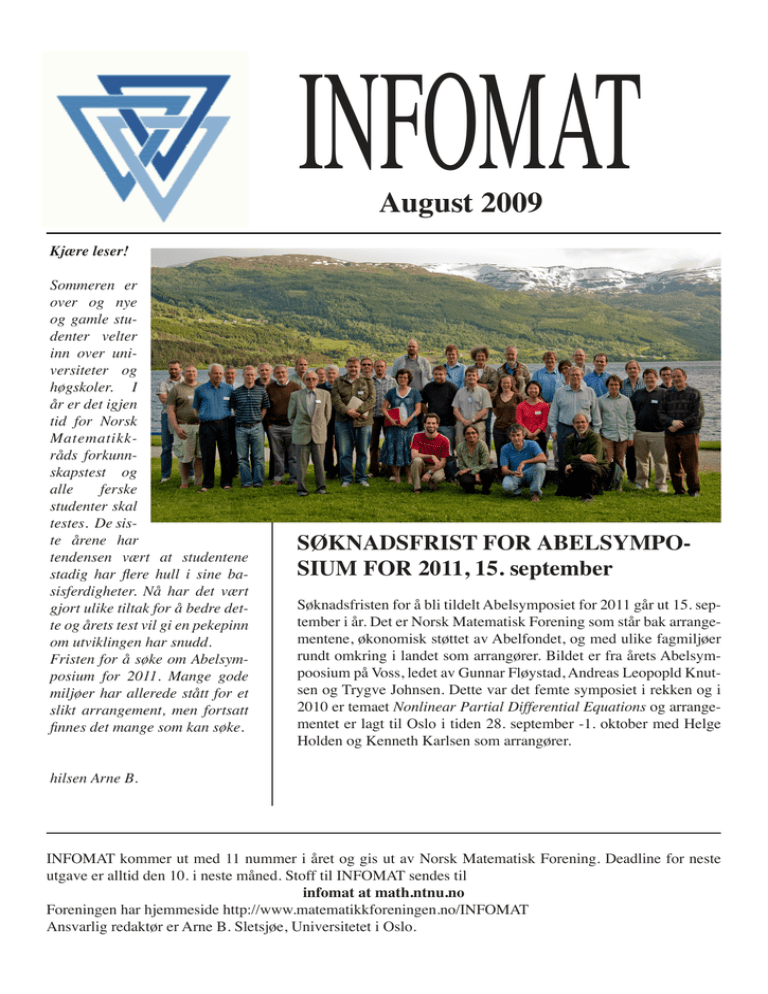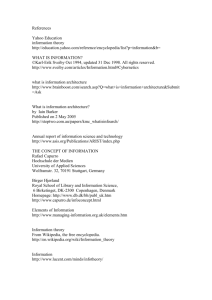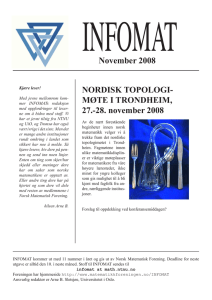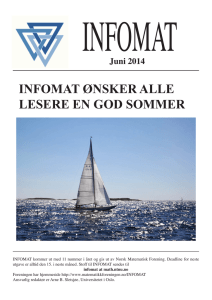INFOMAT August 2009
advertisement

INFOMAT
August 2009
Kjære leser!
Sommeren er
over og nye
og gamle studenter velter
inn over universiteter og
høgskoler. I
år er det igjen
tid for Norsk
Matematikkråds forkunnskapstest og
alle
ferske
studenter skal
testes. De siste årene har
tendensen vært at studentene
stadig har flere hull i sine basisferdigheter. Nå har det vært
gjort ulike tiltak for å bedre dette og årets test vil gi en pekepinn
om utviklingen har snudd.
Fristen for å søke om Abelsymposium for 2011. Mange gode
miljøer har allerede stått for et
slikt arrangement, men fortsatt
finnes det mange som kan søke.
SØKNADSFRIST FOR ABELSYMPOSIUM FOR 2011, 15. september
Søknadsfristen for å bli tildelt Abelsymposiet for 2011 går ut 15. september i år. Det er Norsk Matematisk Forening som står bak arrangementene, økonomisk støttet av Abelfondet, og med ulike fagmiljøer
rundt omkring i landet som arrangører. Bildet er fra årets Abelsympoosium på Voss, ledet av Gunnar Fløystad, Andreas Leopopld Knutsen og Trygve Johnsen. Dette var det femte symposiet i rekken og i
2010 er temaet Nonlinear Partial Differential Equations og arrangementet er lagt til Oslo i tiden 28. september -1. oktober med Helge
Holden og Kenneth Karlsen som arrangører.
hilsen Arne B.
INFOMAT kommer ut med 11 nummer i året og gis ut av Norsk Matematisk Forening. Deadline for neste
utgave er alltid den 10. i neste måned. Stoff til INFOMAT sendes til
infomat at math.ntnu.no
Foreningen har hjemmeside http://www.matematikkforeningen.no/INFOMAT
Ansvarlig redaktør er Arne B. Sletsjøe, Universitetet i Oslo.
ARRANGEMENTER/NYHETER
Matematisk kalender
September:
23.-24. Lær bedre matematikk - undring og utforsking, UiA, Kristiansand
Oktober:
12.-17. An international Conference on Stochastic
Analysis and Applications, Hammamet, Tunisia
2010:
September:
28.-1.oktober:.Abelsymposiet; Nonlinear partial
differential equations, Oslo
LÆR BEDRE MATEMATIKK - UNDRING OG UTFORSKING
Kristiansand, 23.-24. september 2009
Flere opplysninger på http://www.uia.no/no/portaler/aktuelt/konferanser/lbm
ABELSYMPOSIET 2011
Fra instituttene
Professor Maria Luiza Cestari har forskningspermisjon studieåret 09/10
Følgende har forskningspermisjon hele eller
deler av 2009/2010:
•Professor Kari Hag,
•Professor Trond Digernes,
•Førsteamanuensis Jo Eidsvik,
•Førsteamanuensis Harald Hanche-Olsen,
•Førsteamanuensis Espen R. Jakobsen,
•Professor Kristian Seip,
•Førsteamanuensis Ingelin Steinsland,
•Professor Lisa Lorentzen,
•Professor Nils A. Baas
•Førsteamanuensis Anne Kværnø.
Gjester
Osamu Lyama, Hugh Thomas og Robert
Marsh gjester førsteamanuensis Aslak Bakke
Buan i august. Karin Erdmann, Maria InesPlatzeck og Gordana Todorov er gjester hos
professor Idun Reiten.
Kjære kolleger,
på vegne av Norsk matematisk forening vil jeg
be dere om å spre informasjon til eventuelle
søkere og søkermiljøer
ved ditt institutt for Abelsymposiet 2011.
Søknadsfristen er 15. september 2009, og detaljerte instrukser for søknadsprosedyre fins på
http://abelsymposium.no/info.php. Norsk matematisk forening behandler søknadene på vegne av
Abelfondet.
mvh Brynjulf Owren
(leder av Norsk matematisk forening)
Norsk
matematisk
forening
Nye doktorgrader
Olav Skutlaberg forsvarte 14. august 2009 sin
avhandling Topics in Topological Equivalence
of Plane-to-Plane Map-Germs; Sufficiency of
Jets and Classification for ph.d.-graden ved
Universitetet i Oslo.
Franz Georg Fuchs ved Universitetet i Oslo
vil 24. august 2009 forsvare sin avhandling for
graden ph.d. Simulating waves in the solar atmosphere with MHD.
IMO 2009
DEN INTERNASJONALE MATEMATIKKOLYMPIADEN 2009
ET PAR OPPGAVER FRA ÅRETS
IMO
Kina ble beste nasjon i den 50. internasjonale matematikkolympiaden (IMO) i Bremen i
Tyskland i sommer. Laget fikk totalt 221 poeng
av 252 mulige og alle de 6 deltakerne på laget
fikk gullmedalje. Japan ble nest beste nasjon
med 212 poeng, fulgt av Russland med 203 poeng, Syd-Korea med 188 poeng og Nord-Korea
med 183 poeng. Norge ble nummer 63 med 60
poeng. To av nordmennene, Sondre Kvamme og
Jarle Stavnes fikk bronsemedaljer, mens to andre,
Sivert Bocianowski og Karl Erik Holter fikk hederlig omtale (full skår på en oppgave).
Årets IMO samlet 565 deltakere fra 104 nasjoner.
Neste år er det Kazakhstan som er vertskap for
arrangementet, som arrangeres i tiden 2.-15. juli i
hovedstaden Astana.
Oppgave 1.
La n være et positivt heltall, og la a1,...,ak
(k>1)være forskjellige heltall fra mengden
{1,...,n}, slik at n deler ai(ai+1-1) for i=1,...,k-1.
Vis at n ikke deler ak(a1-1).
NORSKE RESULTATER I IMO
Norge deltok i IMO første gang i 1984. Det året ble
John Rognes nummer 53 og fikk bronsemedalje.
Siden den gang har 25 unge matematikktalenter
fått med seg medalje hjem, 26 bronse-, 10 sølvog 2 gullmedaljer. Gullmedaljene ble vunnet av
Jørgen Vold Rennemo, 12. plass i 2008 og David
Kunszenti-Kovács som ble nummer 29 i 2002.
Oppgave 6.
La n være et positivt heltall. La videre a1 , ... , an
være forskjellige positive heltall, og la M være
en mengde bestående av n-1 positive heltall
forskjellige fra s=a1+a2+...+an. En gresshoppe
skal hoppe langs den reelle tallinjen, med start i
0. Den skal gjøre n hopp til høyre med lengder
a1, a2, ...,an i en eller annen rekkefølge. Vis at
denne rekkefølgen kan velges slik at gresshoppen aldri havner i et punkt som ligger i M.
IMO 2010 arrangeres i Astana i Kazakhstan i
tiden 2.-15. juli 2010.
ÅRSMØTE I NORSK MATEMATIKKRÅD
Årsmøtet i Norsk Matematikkråd vil bli
avholdt i Tromsø 17.-19. september 2009.
NYTT FRA IMU
INTERNATIONAL CONGRESS OF
MATHEMATICIANS - 2010
As many of IMU-NET readers would know, India
is to host the International Congress (ICM-2010)
for the year 2010. The congress will take place in
the city of Hyderabad during August 19-27.
Mathematics is the language of science and India
is proud to have coined one of the most important
words of its lexicon - ”zero” - in the distant past; and
we have a long tradition of pursuit of mathematics.
India joined the IMU soon after it was revived after the second world war. The Indian mathematical
community feels greatly honoured that the IMU has
accepted our bid to hold
the ICM 2010 in India,
thereby extending recognition to our efforts at
promoting mathematics.
We look forwrad to welcoming our colleagues
from all over the world
in Hyderabad, the venue of the Congress and expect to learn a great deal that is new. The Congress
will be of great help to us to raise the level of public
awareness about mathematics in our country.
India has been a professional destination for many
mathematicians over the last 75 years and more.
Many British academics had come to India to teach
mathematics in our colleges during the colonial
period. W H Young, the British analyst accepted a
part-time chair, the Hardinge Professorship of Pure
Mathematics in Calcutta University which he held
from 1913 to 1917. Andre Weil spent two years at
an Indian university as a professor during 1930 32.
R A Fisher spent several extended periods of time
at the Indian Statistical Institute in Kolkata (ISI),
his first visit dating back to 1937. ISI laso hosted visits by Norber Wiener and A N Kolmogorov.
Many other distinguished mathematicians, mainly
probabilists from the erstwhile Soviet block visited
ISI during the cold war years. In later years, after
that institution set up branches in Delhi and Bangalore, also at the same time broadening its areas
of research it has had a string of visitors, many of
them big names in matheamtics.
The Tata Institute of Fundamental Research (TIFR),
Mumbai. TIFR too had a regular stream of visi-
tors almost from its inception in 1945, many
of them spending extended periods of time
in Mumbai. Carl Ludwig Siegel and Laurent
Schwarz made several visits each of a duration of two months and more to during the
fifties and sixties. Armand Borel and David
Mumford made several visits to TIFR during
the sixties and seventies (and later). The visitors’ list to TIFR includes several Fields Medalists and other reknowned mathematicians.
The International Colloquiua held once in
every four years by TIFR have been an important forum for international exchange at the
highest level.
To mention a few more distinguished visitors
who spent extended periods of time in TIFR
during the fifties and sixties: H Rademacher,
H Mass, Eichler, J L Lions, K Yosida, B Malgrange, F Bruhat, J P Kahane, M Deuring, G
de Rham, K Ito, G D Mostow, R Bott, R Langlands.......Many others have come on shorter
visits mainly to participate in conferences:
A Selberg, H Grauert, R Thom, A Grothendieck, M F Atiyah, L Hormander, J Milnor, I
Pjatetskii-Shapiro, J P Serre, H Furstenberg,
G A Margulis, D Kazdan .....These visits were
of course of great help to us in building mathematics in the country
Hyderabad the venue of the Congress is home
to several IT companies and rivals Bangalore
as a IT hub in the country. The city is well co
nected, with many airlines flying to and from
it. It was founded in the 15th century and is
steeped in history. It is also famous for its
cuisine. India of course has a lot to offer by
way of tourism catering to a wide range of
interests: wild life, scenic splendour, historical monuments, art and music, great food and
sports as well.
On behalf of the Indian mathematical community I would like to urge mathematicians
from all over the world to participate in ICM
2010 and help us make it a great success.
For more information:
http://www.icm2010.org.in/
M.S. Raghunathan
Chairman of the organizing committee
NYTT FRA IMU
ICM VIDEOS
At ICM 1998 in Berlin the first attempt at an
International Congress of Mathematicians wasmade to record the opening ceremony, plenary
lectures, and other major events on video. The
videos were archived in a format that is ”gone”
in the meantime, but they could be recovered and
transformed with some effort to the current video
standard ”flash”.
The videos are not ”great”, but some of them are
undoubtedly of long term historic interest (e. g.,
see A. Wiles’ lecture on Fermat’s problem). At
ICM 2002 in Beijing most of the major events and
lectures were recorded as well. The video recording at ICM 2006 in Madrid became more professional, but we still have to learn how to ”shoot”
better videos of such events with a very limited
budget.
IMU is grateful to the organizing committees of
these ICMs for donating the videos to IMU and
allowing IMU to place them on the Internet. IMU
is making now the videos produced at these three
ICMs available on its Web site at
http://www.mathunion.org/activities/icm/videos
IMU maintains the copyright of the videos but
gives everyone interested the permission to download and show the videos. IMU just modestly requests to mention where these videos come from.
IMU will continue this tradition and has asked the
ICM 2010 organizing committee to also record the
plenary lectures and the opening ceremony in Hyderabad.
OECD REPORT OF THE GLOBAL
SCIENCE FORUM EXPERTS GROUP
ON MATHEMATICS IN INDUSTRY
The report of the OECD Global Science Forum
Experts Group onMathematics in Industry is now
a public document. It is a reasoned compendium
of mechanisms that can be used for strengthening
the links between industry and academic mathematics. The report is available at
www.oecd.org/sti/gsf
IMUs FORSLAG TIL REVIDERTE
FAGKODER (MSC2010)
00-XX General
01-XX History and biography [See also the
classification number –03 in the other sections]
03-XX Mathematical logic and foundations
05-XX Combinatorics {For finite fields, see
11Txx}
06-XX Order, lattices, ordered algebraic structures [See also 18B35]
08-XX General algebraic systems
11-XX Number theory
12-XX Field theory and polynomials
13-XX Commutative rings and algebras
14-XX Algebraic geometry
15-XX Linear and multilinear algebra; matrix
theory
16-XX Associative rings and algebras {For
the commutative case, see 13-XX}
17-XX Nonassociative rings and algebras
18-XX Category theory; homological algebra {For commutative rings see 13Dxx, for
associative rings 16Exx, for groups 20Jxx,
for topological groups and related structures
57Txx; see also 55Nxx and 55Uxx for algebraic topology}
19-XX K-theory [See also 16E20, 18F25]
20-XX Group theory and generalizations
22-XX Topological groups, Lie groups {For
transformation groups, see 54H15, 57Sxx,
58-XX. For abstract harmonic analysis, see
43-XX}
26-XX Real functions [See also 54C30]
28-XX Measure and integration {For analysis
on manifolds, see 58-XX}
30-XX Functions of a complex variable {For
analysis on manifolds, see 58-XX}
31-XX Potential theory {For probabilistic
potential theory, see 60J45}
32-XX Several complex variables and analytic
spaces {For infinite-dimensional holomorphy,
see 46G20, 58B12}
33-XX Special functions (33-XX deals with
the properties of functions as functions) {For
orthogonal functions, see 42Cxx; for aspects
of combinatorics see 05Axx; for number-theoretic aspects see 11-XX; for representation
NYTT FRA IMU
theory see 22Exx}
34-XX Ordinary differential equations
35-XX Partial differential equations
37-XX Dynamical systems and ergodic theory
[See also 26A18, 28Dxx, 34Cxx, 34Dxx, 35Bxx,
46Lxx, 58Jxx, 70-XX]
39-XX Difference and functional equations
40-XX Sequences, series, summability
41-XX Approximations and expansions {For all
approximation theory in the complex domain, see
30E05 and 30E10; for all trigonometric approximation and interpolation, see 42A10 and 42A15;
for numerical approximation, see 65Dxx}
42-XX Fourier analysis
43-XX Abstract harmonic analysis {For other
analysis on topological and Lie groups, see
22Exx}
44-XX Integral transforms, operational calculus {For fractional derivatives and integrals,
see 26A33. For Fourier transforms, see 42A38,
42B10. For integral transforms in distribution
spaces, see 46F12. For numerical methods, see
65R10}
45-XX Integral equations
46-XX Functional analysis {For manifolds modeled on topological linear spaces, see 57Nxx,
58Bxx}
47-XX Operator theory
49-XX Calculus of variations and optimal control; optimization [See also 34H05, 34K35,
65Kxx, 90Cxx, 93-XX]
51-XX Geometry {For algebraic geometry, see
14-XX}
52-XX Convex and discrete geometry
53-XX Differential geometry {For differential
topology, see 57Rxx. For foundational questions
of differentiable manifolds, see 58Axx}
54-XX General topology {For the topology of
manifolds of all dimensions, see 57Nxx}
55-XX Algebraic topology
57-XX Manifolds and cell complexes {For complex manifolds, see 32Qxx}
58-XX Global analysis, analysis on manifolds
[See also 32Cxx, 32Fxx, 32Wxx, 46-XX, 47Hxx,
53Cxx] {For geometric integration theory, see
49Q15}
60-XX Probability theory and stochastic processes {For additional applications, see 11Kxx,
62-XX, 90-XX, 91-XX, 92-XX, 93-XX, 94-XX}
62-XX Statistics
65-XX Numerical analysis
68-XX Computer science {For papers involving machine computations and programs in a
specific mathematical area, see Section –04 in
that area}
70-XX Mechanics of particles and systems
{For relativistic mechanics, see 83A05 and
83C10; for statistical mechanics, see 82-XX}
74-XX Mechanics of deformable solids
76-XX Fluid mechanics {For general continuum mechanics, see 74Axx, or other parts
of 74-XX}
78-XX Optics, electromagnetic theory {For
quantum optics, see 81V80}
80-XX Classical thermodynamics, heat
transfer {For thermodynamics of solids, see
74A15}
81-XX Quantum theory
82-XX Statistical mechanics, structure of matter
83-XX Relativity and gravitational theory
85-XX Astronomy and astrophysics {For celestial mechanics, see 70F15}
86-XX Geophysics [See also 76U05, 76V05]
90-XX Operations research, mathematical
programming
91-XX Game theory, economics, social and
behavioral sciences
92-XX Biology and other natural sciences
93-XX Systems theory; control {For optimal
control, see 49-XX}
94-XX Information and communication, circuits
97-XX Mathematics education
Det er åpent for kommentarer på
http://msc2010.org/mscwiki/index.
php?title=Main_Page
NOTISER
PRINCETON TEAM’S ADVANCE IN
PACKING PROBLEM IN NATURE
BRINGMANN RECEIVES ONE
MILLION EURO KRUPP PRIZE
Princeton researchers have beaten the present
world record for packing the most tetrahedra into
a volume. Research into these so-called packing problems have produced deep mathematical
ideas and led to practical applications as well.
Princeton University/Torquato Lab. ”Finding
the best way to pack the greatest quantity of a
specifically shaped object into a confined space
may sound simple, yet it consistently has led to
deep mathematical concepts and practical applications, such as improved computer security
codes. When mathematicians solved a famed
sphere-packing problem in 2005, one that first
had been posed by renowned mathematician and
astronomer Johannes Kepler in 1611, it made
worldwide headlines. Now, two Princeton University researchers [Salvatore Torquato, a professor in the Department of
Chemistry and the Princeton Institute for the
Science and Technology of Materials, and Yang
Jiao, a graduate student in the Department of
Mechanical and Aerospace Engineering] have
made a major advance in addressing a twist in
the packing problem, jamming more tetrahedra-solid figures with four triangular faces--and other polyhedral solid objects than ever before into
a space. The work could result in better ways
to store data on compact discs as well as a better understanding of matter itself. Henry Cohn,
a mathematician with
Microsoft
Research
New England in Cambridge, Mass. says, ’the
Princeton researchers,
have thrown out a new
challenge to the math
world. Their results
could be considered a
21st Century analogue
of Kepler’s conjecture
about spheres. And, as
with that conjecture, I’m sure their work will inspire many future advances.’” (from the Princeton University press release)
The research is published in the August 13 issue
of Nature and is featured on the cover.
Kathrin Bringmann, a number theorist at the
University of Minnesota and the University of
Cologne, has been awarded the Alfried KruppFörderpreis for Young Professors. The one
million Euro prize, for a five-year period, is
awarded by the Alfried Krupp von Bohlen und
Halbach Foundation. She is the third mathematician to win the annual prize--Ursula Gather
received the prize in 1987 and Albrecht Böttcher won in 1992. Bringmann is well known
for her joint work with her postdoctoral mentor
Ken Ono (University of
Wisconsin-Madison) on Ramanujan’s mock
theta functions, which Ramanujan wrote about
in 1920 as he was dying, although he did not
provide details about the functions, including their definition. Following seminal work
of the Dutch mathematician Sander Zwegers,
Bringmann and Ono have built and applied
their theory to many topics in mathematics:
partitions and q-series, Moonshine, and elliptic
curves, to name a few. On the mock theta functions, Bringmann said, ”Imagine that a famous
composer left, after his death, a symphony
written in a secret code that only he himself
could read.” More information about the prize
and Bringmann’s research (in German) is at the
DMV (Deutsche Mathematiker-Vereinigung)
website.
EUROPEISKE PRESIDENTER
Her er presidentene i de europeiske matematikkforeningene samlet til
møte i Polen i mai i år.


